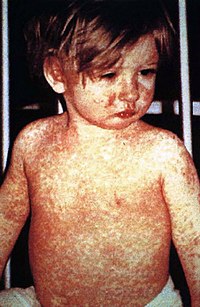
Photo from wikipedia
INTRODUCTION Intestinal-cutaneous fistulas (ICFs) constitute a major surgical challenge. Definitive surgical treatment of ICFs continues to be associated with significant morbidity. The purpose of this study was to utilize a… Click to show full abstract
INTRODUCTION Intestinal-cutaneous fistulas (ICFs) constitute a major surgical challenge. Definitive surgical treatment of ICFs continues to be associated with significant morbidity. The purpose of this study was to utilize a nationwide database to define the morbidity associated with current treatment strategies in the surgical management of ICFs. METHODS The 2006-2017 American College of Surgeon National Surgical Quality Improvement datasets (ACS-NSQIP) were used to assess 30-day morbidity and mortality after surgical repair of ICFs. Outcomes for emergent repair were compared to elective repair of ICFs. RESULTS Overall, 4197 patients undergoing ICF-repair were identified. Mean age was 55.9 (SD 15.3). Patients were generally comorbid (62.9% were in ASA class III). The observed in-hospital mortality was 2.3%. However, the observed morbidity rate was 47.3%. Of the observed morbidity, 35.6% was due to post-operative infectious complications (superficial surgical site infections (SSI), deep SSI, organ/space SSI, wound disruption, pneumonia, urinary tract infection (UTI) sepsis or septic shock). The most common infectious complication was sepsis (13.1%). 30-day readmission rate was 15.3% and the 30-day reoperation rate was 11.0%. Emergent repair was associated with a sevenfold increase in mortality (11.9% vs 1.8%, P < 0.001) CONCLUSION: The management of patients with ICFs is complex and is associated with significant morbidity. Half of patients undergoing surgical management of ICFs developed in-hospital complications.
Journal Title: American journal of surgery
Year Published: 2020
Link to full text (if available)
Share on Social Media: Sign Up to like & get
recommendations!